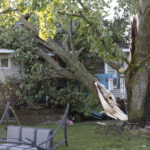South Carolina Gov. Mark Sanford named state Sen. Scott Richardson as the director of the Department of Insurance about one year ago, replacing Eleanor Kitzman. Richardson was elected to the South Carolina Senate in 2000, and previously served in the S.C. House from 1993 through 1996. He has worked in insurance and real estate. In the Senate, he served on the Finance Committee and the Banking and Insurance Committee.
Richardson takes on regulation, catastrophe modelers, Congress and A.M. Best in this edited version of a video interview with Insurance Journal’s Andy Simpson conducted at last fall’s meeting of the National Association of Insurance Commissioners.
You’ve got a legislative background and years of industry experience. How does this affect your view as a regulator?
Richardson: I think it helps a lot. It really gives you a lot of insight about when you, maybe when you’re getting too tedious about things. What I call inside the beltway mentality, because I think that’s one of the things that we have to deal with. We have our own beltway, really, at the NAIC, and at the end of the day what we really need to be worried about is what does Bubba think about the policy, or how it’s being handled, because they’re the ultimate consumer.
In the summer Gov. Sanford signed a bill dealing with coastal insurance. What has that legislation accomplished?
Richardson: …I guess the main thing that we focused on is incentives. We don’t want government insurance in South Carolina. I would say that, first off. So what we set about doing is saying, “OK, how can we put things in motion? How can we encourage people to do things? Encourage people to do mitigation. Encourage people to write things that maybe they don’t want to right now.”
We put tax incentives to companies. We put tax incentives to individuals to mitigate their houses. Tax incentives for creating deductible savings accounts. All of the things that you ought to be doing, but maybe a little push would help.
Because we think that’s the real answer. You can’t change the catastrophe exposure itself. None of us knows when it’s coming or where it’s coming or how bad it’s going to be. But we can put more straps on a roof. We can put more resistant windows in a house. There are lots of things you can do, and we’ve got 50 years of construction that frankly we’ve got to go back and retrofit a lot of stuff if we’re really going to mitigate a Katrina-sized hurricane.
Were there any incentives for insurers?
Richardson: Yes. We give them about a 20 percent discount on their insurance premium taxes if they write wind coverage in certain areas.
Is the law working?
Richardson: Well, the market is very good. I will have to say that, knock on wood, we have been very lucky and I think the industry has appreciated our attitude, which is just fully market driven. We hadn’t sort of gone the draconian route of creating any kind of South Carolina Reinsurance Fund and all of those things. Who knows? Maybe someday we’ll have to go there, but we’ve resisted that.
I went to the Legislature, and I think, having been a legislator up until the time I took this job, it was a little easier to talk to people and say, “Hey, give us a chance on this. Let us try to do it this way. Let it work. Give us a year or two, and see if this will work. If it doesn’t, we can start on other things, but we don’t need to be doing what Florida’s doing.”
You live on the coast. How’s your insurance?
Richardson: Got cancelled. [laughs] Had to replace it. But I think there’s a good story there. I had four options. My coverage was cancelled, but it was actually a company that was getting out of everything they were doing in the state. I had four really good options, and ended up getting coverage that was about the same price. Had some higher deductibles, but it shows that there’s a marketplace, and that was a good thing.
What do you think went on in the insurance company when they saw it was your policy?
Richardson: It became a whole human interest story across the country. It got in USA Today and magazines all over the country. “They cancelled the insurance commissioner’s policy.” I was getting e-mails from all over the country, which was really funny. People going, “Where’s that guy working now?”
The governor also signed workers’ compensation legislation that eliminated the second injury fund. What other changes has that law brought?
Richardson: Well, we’ve still got to get to the AMA [American Medical Association] guidelines. That’s the big banana. The things that we did were good. Getting rid of the second injury refund and a lot of those things which are very technical things. …
The biggest problem that you’ve got in South Carolina is the unpredictability of going to the work comp commission, and having decisions that many of us think are just not really based on normal factual circumstances and the kind of percentages that we get in relation to a work comp decision. Most states average something like 126 percent of the AMA guidelines, and we’re 185 percent. There are too many arbitrary decisions where we didn’t feel like there was empiric information to back up that kind of decision. So, the governor has stepped in and said, “Look, I’m telling you. I appoint the work comp commissioners. This is what I expect. I expect South Carolina to follow AMA guidelines.” Which I think … It’s a bully pulpit thing. There’s nothing he can do legally, but if you’re on the work comp commission, and you didn’t get that message, you’re not paying attention.
[I]’ll tell you the most interesting thing about that is the first day, within 24 hours of when the governor came out, I had two major carriers in our state call me up and ask if we would walk through filings. That they would reduce their rates by 16 percent. One 10 percent and one 16 percent immediately. … They were ready to do that that second, which I thought spoke volumes to the whole thing. They hadn’t said that about any of the other provisions.
Your state has made inroads in the captive industry. What’s made this possible?
Richardson: We started in captives in 2000, but I think we sort of learned from other people’s mistakes that were out there, which everybody does. But we started off with a real good body of laws, and in 2000, we went after it aggressively. Had people out there looking at it. We tweaked when we could tweak. The legislature gave us ability to do it. What we’ve done now in our last push, is we’ve really ramped up the people that handle it. We’re number one in securitizations. I don’t think there’s anybody out there that knows more about securitization transactions than Leslie Jones, who’s in our department who does that. It’s that expertise.
…We’re turning around the things. My real thing … I told to my staff is, if we don’t want to do a captive, for whatever reason, tell somebody no immediately, or “No, but if you change two or three things, OK.”
… And if we are going to do it, get it done, get it out of here in 30 days. … The people are doing it because they need it now. They don’t want to wait six months or a year and so forth.
The U.S. House of Representatives recently passed a measure that would add windstorm coverage as an option to the federal flood policy. Is that a good idea?
Richardson: I think it’s a terrible idea. I really do. There’s so much in that. Well, first of all, the federal flood insurance program has got significant problems right now. The flood maps aren’t accurate, in my opinion, and that’s been that way for a long time, and I had to deal with them … for 20-something years. My agency that my partners an I owned was on the coast, a very large agency and all we did was basically coastal-type business. We were, at one time … the largest writer of federal flood insurance, and so I’ve had a lot of experience with that. It’s got problems. I mean, it’s a good idea, but it does have problems.
So, to me, why would you want to take a federal program that’s got problems and make it five times bigger than it is? There’s a lot of stuff in that law that really hadn’t been drilled deep enough. … I just think it’s premature, and, frankly, I don’t want to let the industry off the hook yet. I’m a market-driven person, and I think that the insurance industry needs to solve this problem. …
You mentioned catastrophe models. There’s been some discussion about whether state regulators should have access to the proprietary information third parties use to produce these models. What do you think?
Richardson: I don’t know. You can sort of operate on a bogeyman theory that, if there’s something they won’t show you, there’s something there. That’s not my nature. I’m not all excited about seeing whatever their proprietary information is. I’m much more concerned about the financial strata that they use. For instance, is this a five-year model? Are you talking about a company trying to regain their assets in five years, 20 years, and 50 years? Because I think that’s the crux of it.
I mean, all of these other things tweak it; they go in there and they show different percentages. But at the end of the day, to the consumer, to the rate maker, if you want to bring me a model that a company’s going to bring me to justify giving them a 200 percent rate increase so that they can get their money back in five years on a 100-year storm, I’m going to say no. I mean, that’s not possible. The consumer can’t pay that.
… My big beef right now is with A.M. Best, who is rating the insurance companies. They have, just really overnight, in the last 18 months, gone to companies and said, “OK, these models are out there. They’re saying that it could be worse than you said. So, instead of being able to withstand one 100-year storm, we think you should be able to withstand two 100-year storms and another event.” So you say, “Well, when does that start?” “Tomorrow.”
…[W]hat do you think would happen in the world banking industry if A.M. Best came out tomorrow and said, “All this sub-prime mortgage thing and all these problems, we really think banks should have 16 percent reserves instead of 8, and 5 percent cash instead of 2?” You’d crash the banking industry. But that’s what they did, simplistically talking … to the insurance companies and said, “OK, you’ve got to have all this surplus.” So then the companies come to the regulators and say, “I’ve got to have more rate, because I’ve got to have more surplus. And if I don’t get the rate, then I’ve got to cancel people.” I mean, it’s this death spiral that it goes into … I think it’s a discussion that has to be had.
Was this article valuable?
Here are more articles you may enjoy.


 Trump Administration Turning to Private Firms in Cyber Offensive
Trump Administration Turning to Private Firms in Cyber Offensive  One of Highest Property Claims Severity Recorded in Q3 on Low Volume, Says Verisk
One of Highest Property Claims Severity Recorded in Q3 on Low Volume, Says Verisk  Chubb, The Hartford, Liberty and Travelers Team Up on Surety Tech Launch
Chubb, The Hartford, Liberty and Travelers Team Up on Surety Tech Launch  AIG Gets Approval to Acquire Everest Renewals in 6 EU Countries – in Time for Jan. 1
AIG Gets Approval to Acquire Everest Renewals in 6 EU Countries – in Time for Jan. 1 


